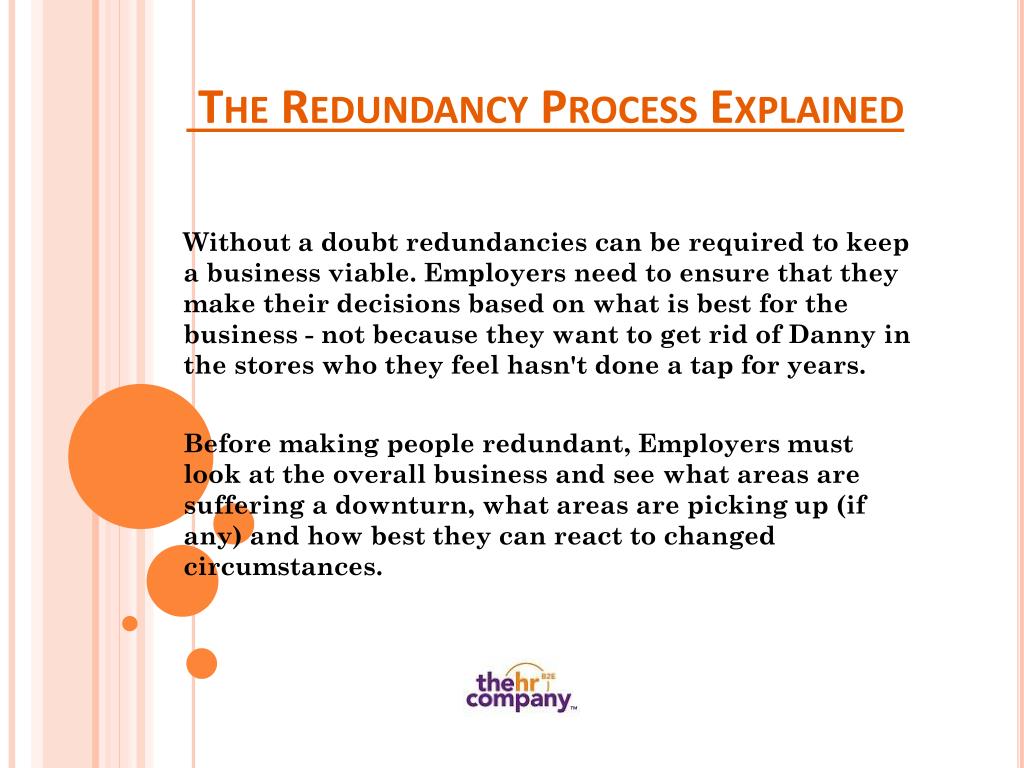Described: If a Company Goes Bust Who Pays Redundancy in the UK?
Described: If a Company Goes Bust Who Pays Redundancy in the UK?
Blog Article
Exploring the Interplay In Between Company Redundancy and Organizational Adaptability for Future Development
In the vibrant landscape of today's service globe, the elaborate relationship in between firm redundancy and business flexibility arises as a vital variable for continual growth and success. Business usually encounter the challenge of striking a fragile balance in between maintaining a degree of redundancy to mitigate threats and promoting flexibility to respond promptly to the ever-evolving market needs.
Relevance of Firm Redundancy
Business redundancy is a vital aspect that enhances business durability and reduces functional risks. By incorporating redundancy procedures within the business structure, companies can much better stand up to unpredicted disturbances and fluctuations in business atmosphere. Redundancy functions as a tactical buffer, permitting companies to adapt and react successfully to unanticipated challenges without jeopardizing necessary procedures.
One key facet of the relevance of company redundancy is its duty in ensuring connection during times of crisis. When confronted with sudden modifications or emergency situations, redundant systems, sources, or personnel can tip in to preserve essential functions and avoid extensive interruptions. This connection not only safeguards the business's credibility and consumer depend on yet additionally minimizes economic losses and operational downtime.

Approaches for Organizational Versatility

One more important technique is buying modern technology and framework that can support flexibility and scalability. Applying electronic tools, automation, and information analytics can enhance procedures, improve performance, and provide important insights for educated decision-making. Moreover, developing adaptable organizational frameworks that enable fast modifications to market characteristics and customer demands is necessary for staying competitive in a swiftly advancing atmosphere. By proactively recognizing potential disturbances and opportunities, organizations can proactively adapt and prosper in an ever-changing service landscape.
Balancing Redundancy and Flexibility
Accomplishing an unified balance between functional redundancy and business flexibility is paramount in navigating the intricacies of a dynamic organization setting. Striking the appropriate equilibrium in between redundancy and flexibility is a delicate procedure that needs a deep understanding of the organization's goals, market characteristics, and threat resistance.
To accomplish this balance, business require to carry out normal evaluations of their operations to recognize useful site locations where redundancy is necessary for risk mitigation and where versatility can drive innovation and growth. Executing versatile structures, cultivating a culture of constant discovering and improvement, and motivating open interaction throughout all degrees of the organization are vital methods to balance redundancy and versatility properly. By lining up these two vital elements, companies can position themselves for sustainable development and success in an ever-changing business landscape.
Situation Studies on Adjustment Success
In taking a look at instances of effective organizational adaptation, it comes to be evident that the interplay in between functional redundancy and adaptability is a specifying variable in shaping resistant services. One engaging instance study is that of Netflix. At first a DVD rental service, Netflix showed amazing flexibility by transitioning right into a streaming platform when digitalization interrupted the industry. By tactically purchasing technology and web content development, Netflix not only thrived but survived in a quickly evolving market. Another standout example is Amazon. Starting as an on-line book shop, Amazon continuously adjusted its service design, broadening right into varied sectors such as cloud computer and man-made intelligence. This flexibility enabled Amazon to stay ahead of rivals and fulfill transforming consumer demands. Lastly, Adobe provides a noteworthy picture of effective adaptation. The firm shifted from marketing software application licenses to a subscription-based model, making certain persisting income streams and improved consumer interaction. These instance researches underscore the importance of operational redundancy paired with organizational flexibility in cultivating long-lasting growth and competition.
Building Resilience for Future Development
Building strength for future growth requires a calculated placement of functional procedures with market characteristics and emerging trends. Companies have to adjust to altering settings by cultivating a culture of versatility, technology, and continuous renovation. Resilience involves not just getting better from why not look here setbacks but also proactively planning for future difficulties. One crucial aspect of building durability is investing in robust threat monitoring approaches to mitigate you could look here possible disruptions. This includes circumstance planning, expanding supply chains, and creating contingency prepare for different backups (who pays redundancy money).
Furthermore, fostering solid partnerships with stakeholders, such as consumers, employees, vendors, and the area, is necessary for preserving and weathering uncertainties trust and assistance during unstable times. Effective communication and openness play a crucial function in building strength, as they help promote and line up assumptions collaboration in navigating uncertainties.
Moreover, companies require to prioritize knowing and growth efforts to upskill employees and equip them with the essential tools to adjust to changing conditions. By buying their labor force, companies can enhance their versatility and agility, eventually reinforcing their resilience for sustainable future growth.
Conclusion

In the vibrant landscape of today's organization world, the elaborate relationship in between business redundancy and business adaptability arises as a critical element for continual development and success. Companies commonly face the difficulty of striking a delicate equilibrium between maintaining a level of redundancy to mitigate dangers and fostering adaptability to react swiftly to the ever-evolving market needs.To achieve this balance, companies need to carry out regular assessments of their procedures to determine locations where redundancy is required for risk mitigation and where flexibility can drive advancement and development.In conclusion, the interplay in between company redundancy and organizational adaptability is critical for future growth. Structure durability with a mix of redundancy and flexibility will make certain that business are prepared for the difficulties of the future.
Report this page